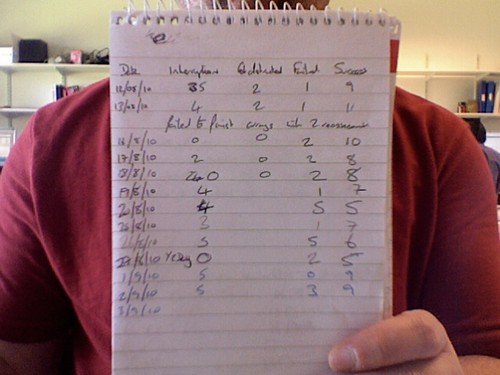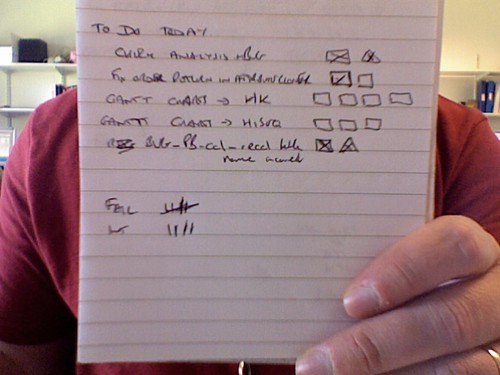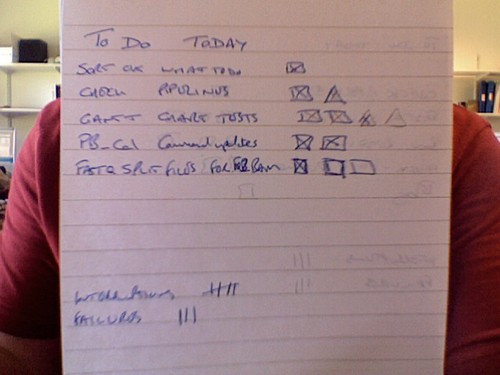Arriving about 8.30ish, I chatted with a couple of people from the previous day, and we went through for the second Keynote, Building Trust in Agile Teams - Rachel Davies. Rachel is the co-author of Agile Coaching, and talked a lot about trust. What is trust, how do we trust people (both socially and in the work environment), and how do we build trust. Examples included borrowing £20 of a member of the audience, and doing the falling backwards into a group of peoples arms (which worked, and Rachel actually seemed a bit scared of the volunteers going through with). This was an excellent keynote. Rachel is a great speaker, and presented the material in a very easy to understand way.
After a coffee break, for me it was back into the Gilb Theatre for Scrum/XP Add-ons workshop, presented by Jon Mullen and Paul Fairless from BSkyB. The organisation of this was different, in that, with a bit of PowerPoint trickery, they were able to allow us to choose the order of the presentation topics. We did some voting (What we preferred, what our teams did agile), we choose the order we would put 'stories' based on complexity (I clearly thought that baking and decorating a cake for 20 was more complex than washing and waxing a car). The method of this though was (I thought) better than story poker). A story card is put on the table, then each person in turn either puts a new card either side (or between), or moves a card. This continues until an order is established of complexity. After this, the cards are then graded 1->8 for measure of complexity. They gave an excellent description of the way that they work (1 week sprints, pair programming, office layout), and a great little video (with sweets!) of a scrum (that had a number of things wrong with it). It all finished with an attempt to win a bottle of bubbly, in a game like they play on a Friday afternoon.
Next was lunch, and possibly the biggest thing ever to render me speechless. Rachel caught me and complimented my talk on the Pomodoro Technique. I was quite shocked, and as such completely failed to mention how much I had enjoyed her talk (Sorry Rachel). Here was someone who is experienced in presenting, complementing me on mine. After a little discussion about how I might start bringing Agile into my team here (including the idea of a taskboard, that needn't be on full display the whole time), she moved off and I had another Chat with Martin from Aptivate who was telling me about the work they had gone out to do in Zambia bringing women out there up to speed with IT, including the setting up of an Internet Cafe and training staff. It's great to hear about people doing this sort of work, and a shame that they possibly aren't getting as much funding this year to do it as fully as they have done in previous years.
After lunch, the final workshops session. I opted for Visual Management for Agile Teams - Xavier Quesada Allue. In this, we were tasked with creating a Taskboard which would be the focus of the scrum, and would keep track of stories, tasks, if we were on track, who was doing what and backlog.
Here is the one my team came up with
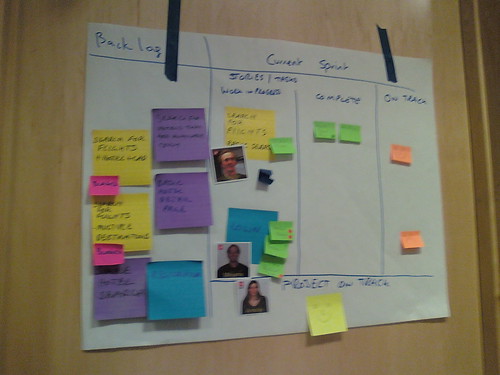
Although, as we went around the room, no two boards were the same. One team (featuring Conny) opted for a Kanban approach
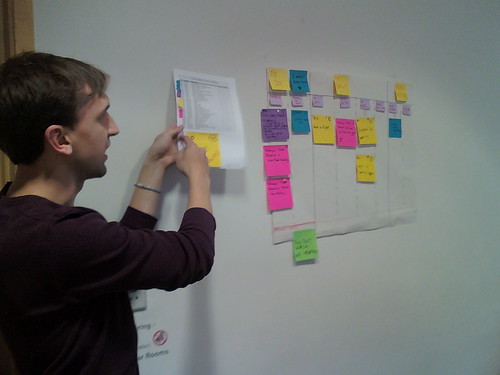
But the coolest had their stories on hearts, which moved along a track. If they stopped, they picked up hairs (a rolling stone gathers no moss) or broke if they were blocked in any way.
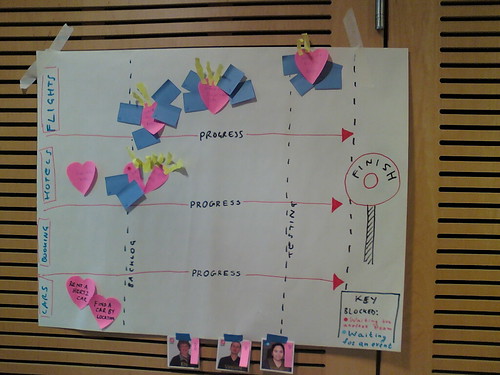
This was a great way of getting on task with using a board, and showed that I think if the team is involved in the design, it probably adds more ownership and encourages it's use more.
Xavier also showed us some pictures of taskboards he had helped develop for teams. This was an excellent workshop, and well worth attending.
After the final coffee break of the conference (a chance to make sure people had my twitter alias - setitesuk), we headed back into the Gilb theatre for a panel Q&A session 'Creating a Development Process for your Team: What, How and Why'. The panel was led by Giovanni Asproni, who I met the previous day in Bob Marshalls workshop, and who previously worked at the EBI (so right next door to me!). Beforehand he admitted that he was happy to do lead the session, since he didn't need to do much talking (I must remember that trick next time).
The panel consisted of a number of the speakers from the 2 days (although I can only remember the names of Rachel, Allan Kelly and Willem). The main topic eventually was a debate around pair programming, although other aspects of Agile got mentioned (and even the Pomodoro Technique got dropped in as noting it had become a discussion point - yay me :) ).
I must say, that after two days I was starting to flag a little, so picked up the least amount from this session, but it was interesting nonetheless, and rounded off the two days in a great way.
Mark closed off the conference, and we all left (after grabbing more choccies from the RedGate guys!)
Overall, the conference for me was a great success. An opportunity to find out lots about Agile process. A steep learning curve in places, and just a great opportunity to meet others who are producing great software. My favourite workshop/talk has got to go to Gojko and David for 'The Specification Game', for the great way of teaching us all what we do wrong (it is certainly true that you learn more getting it wrong than right), and favourite snippet goes to James A. Whittaker for being so surprised that so many of us Brits still use a phone book.
Of all my sessions that I had my time again, I would have chosen not to go to, would be Code Debt. As I mentioned in my previous blog, not because it was lacking, but that it was the least relevant to Agile.
Thanks to Mark Dalgarno and his team for organising a great Conference, at a fantastic venue. Thanks to all the speakers that I saw, if I could present even half as well as you all, I'd be happy, and your material was in general excellent. Thanks to everyone I met for engaging discussions, and thanks to RedGate Software for the beers!
I look forward to next year.
